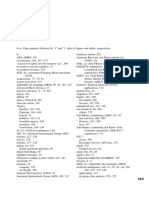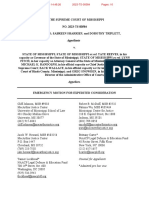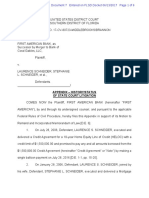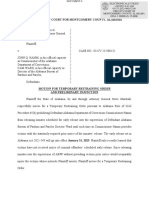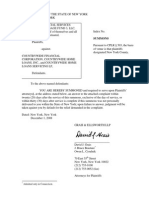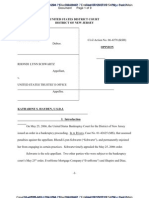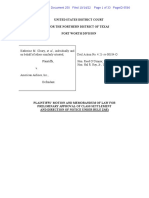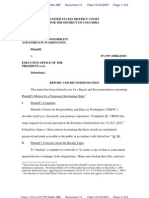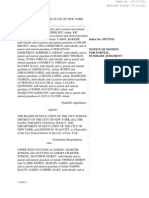0 ratings0% found this document useful (0 votes)
114 viewsFindings of Fact, Conclusions of Law, and Order Re: Rule 11
Findings of Fact, Conclusions of Law, and Order Re: Rule 11
Uploaded by
griz8791MT 8th Jud. Dist. Judge Pinski finds BNSF's assertion of contributory negligence defense violated Rule 11.
Copyright:
© All Rights Reserved
Available Formats
Download as PDF, TXT or read online from Scribd
Findings of Fact, Conclusions of Law, and Order Re: Rule 11
Findings of Fact, Conclusions of Law, and Order Re: Rule 11
Uploaded by
griz87910 ratings0% found this document useful (0 votes)
114 views10 pagesMT 8th Jud. Dist. Judge Pinski finds BNSF's assertion of contributory negligence defense violated Rule 11.
Original Title
2014-10-09 Rule 11 Order
Copyright
© © All Rights Reserved
Available Formats
PDF, TXT or read online from Scribd
Share this document
Did you find this document useful?
Is this content inappropriate?
MT 8th Jud. Dist. Judge Pinski finds BNSF's assertion of contributory negligence defense violated Rule 11.
Copyright:
© All Rights Reserved
Available Formats
Download as PDF, TXT or read online from Scribd
Download as pdf or txt
0 ratings0% found this document useful (0 votes)
114 views10 pagesFindings of Fact, Conclusions of Law, and Order Re: Rule 11
Findings of Fact, Conclusions of Law, and Order Re: Rule 11
Uploaded by
griz8791MT 8th Jud. Dist. Judge Pinski finds BNSF's assertion of contributory negligence defense violated Rule 11.
Copyright:
© All Rights Reserved
Available Formats
Download as PDF, TXT or read online from Scribd
Download as pdf or txt
You are on page 1of 10
1
MONTANA EIGHTH JUDICIAL DISTRICT COURT, CASCADE COUNTY
______________________________________________________________________________
)
MICHAEL D. SCHNITTGEN, )
) Cause No. ADV-13-168
Plaintiff, )
)
vs. ) FINDINGS OF FACT, CONCLUSIONS
) OF LAW, AND ORDER RE: RULE 11
BNSF RAILWAY CO., a corporation, )
)
Defendant. )
____________________________________)_________________________________________
INTRODUCTION
This matter is before the Court on Plaintiff Michael Schnittgens Motion for Rule 11
Sanctions filed on June 20, 2014. [Doc. 90]. Defendant BNSF Railway Co. responded on July
7, 2014. [Doc. 96]. Schnittgen replied on July 21, 2014. [Doc. 100]. The Court held a hearing
on September 23, 2014.
John A. Kutzman and Anthony S. Petru appeared for Schnittgen. Thomas L. Beam,
Anthony M. Nicastro, and Maxon R. Davis appeared for BNSF. Mr. Davis was retained by
BNSF after this motion was filed, and he is not responsible in any way for the Rule 11 violations
or sanctions.
The Court, having considered all of the pleadings, records, files and oral argument, issues
the following Findings of Fact, Conclusions of Law, and Order.
2
FINDINGS OF FACT
1. On July 19, 2011, Plaintiff Michael Schnittgen and engineer Randy Zeman were
driving a BNSF train from Stanford to Great Falls.
2. A BNSF dispatcher in Ft. Worth, Texas, issued a track warrant authorizing the
train to proceed from milepost 205 to the Great Falls yard. The track warrant did not warn of
any open switches that might divert the train onto an adjacent track.
3. When the train reached Gerber, about 12 miles southeast of Great Falls,
Schnittgen noticed the track switch was open, diverting them onto an adjacent track. The train
collided with a parked train. Schnittgen was injured in the collision.
4. In its internal investigation, BNSF determined Andre Kaluza failed to close the
switch. BNSF also found Kaluza improperly reported to BNSF dispatch the switch was closed.
Kaluza admitted his failure. BNSF fired Kaluza.
5. BNSF cleared Schnittgen of wrongdoing. The collisions cause was so clear
BNSF did not request Schnittgen submit a drug and alcohol test.
6. Schnittgen sued BNSF for his injuries under the Federal Employers Liability Act,
45 U.S.C. 51, et seq., on February 26, 2013. [Doc. 1].
7. BNSF answered on June 28, 2013. [Doc. 4]. In its Answer, BNSF admitted the
collision occurred, but denied liability and asserted contributory negligence.
8. On July 10, 2013, Schnittgen demanded BNSF admit liability and withdraw its
contributory negligence defense.
9. In an Amended Answer filed on September 19, 2013, BNSF maintained its
contributory negligence defense, but averred:
6. Defendant admits that Plaintiff was working for BNSF as a
conducted on July 19, 2011 on a train near Great Falls and that Mr.
3
Kaluza, an employee of 17 years, operated a sliding switch to
allow the Georgetown train to pull into the siding and off the
mainline tracks. Mr. Kaluza forgot to reline the switch and the
train Plaintiff was working on entered the siding and hit the
Georgetown train. Three locomotives and 10 cars of out of the 110
cars on Plaintiffs train derailed.
7. Defendant does admit that an employee of 17 years failed to
exercise reasonable care when he forgot to reline a switch to
mainline travel and if he had relined the switch then Plaintiffs
train would have traveled down the mainline instead of into the
siding and hitting the Georgetown train and derailing three
locomotives and 10 cars out of 110.
(Am. Ans. 6-7). [Doc. 11]. BNSF contends this admits liability.
10. On May 12, 2014, Schnittgen moved for partial summary judgment on liability
and contributory negligence. [Doc. 41.2]. Schnittgen separately served, but did not file, his
motion for Rule 11 sanctions. Schnittgen again demanded BNSF withdraw its contributory
negligence defense. BNSF refused.
11. The Court granted partial summary judgment for Schnittgen on August 28, 2014.
[Doc. 102].
CONLCUSIONS OF LAW
From the foregoing Findings of Fact, the Court enters the following Conclusions of Law:
1. Any Conclusion of Law in the preceding Findings of Fact is incorporated as a
Conclusion of Law.
2. This Courts findings of fact are reviewed on whether they are clearly erroneous
and the conclusions of law for abuse of discretion. See Davenport v. Odlin, 2014 MT 109, 9,
374 Mont. 503, 327 P.3d 478. A court abuses its discretion when it acts arbitrarily without
conscientious judgment or exceeds the bounds of reason resulting in substantial injustice. See
Larchick v. Diocese of Great Falls-Billings, 2009 MT 175, 39, 350 Mont. 538, 208 P.3d 836.
4
3. By presenting a pleading to the Court, BNSF represents that to the best of its
knowledge, information and belief, formed after completing a reasonable inquiry:
(1) it is not being presented for any improper purpose, such as
to harass, cause unnecessary delay, or needlessly increase
the cost of litigation;
(2) the claims, defenses, and other legal contentions are
warranted by existing law or by nonfrivolous argument for
extending, modifying, or reversing existing law or for
establishing new law;
(3) the factual contentions have evidentiary support or, if
specifically so identified, will likely have evidentiary
support after a reasonable opportunity for further
investigation or discovery; and
(4) the denials of factual contentions are warranted on the
evidence or, if specifically so identified, are reasonably
based on belief or lack of information.
Rule 11(b), MRCP.
4. The purpose of Rule 11 is to discourage dilatory or abusive tactics and help to
streamline the litigation process by lessening frivolous claims or defenses. Byrum v. Andren,
2007 MT 107, 32, 337 Mont. 167, 159 P.3d 1062. Before a district court may impose
sanctions under Rule 11, it must conduct a hearing for that purpose, so the party will be
provided with due process before it is punished. Id.
5. Schnittgen notified BNSF of the alleged Rule 11 violations before filing his
motion. Schnittgen provided BNSF with a reasonable opportunity to withdraw its frivolous
defense before filing his Rule 11 motion. Schnittgen complied with Rule 11(c)(2), MRCP.
6. This Court followed the due process requirements under Byrum. BNSF was
notified of the Rule 11 motion. BNSF filed a written response. A hearing was held on
5
September 23, 2014. The Court will hold a post-trial hearing before entering sanctions. The
Court complied with Rule 11(c)(1). MRCP.
7. This Court has broad discretion in imposing sanctions under Rule 11. See Morin
v. State Farm Mut. Auto. Ins. Co., 2013 MT 146, 33, 370 Mont. 305, 302 P.3d 96. A district
court has the flexibility to deal appropriately with violations of Rule 11 and to tailor sanctions to
fit the particular case. Id. (citing Gold Reserve Corp. v. McCarty, 228 Mont. 512, 515, 744 P.2d
160 (1987)). This Court is in the best position to evaluate the credibility of the evidence in a
Rule 11 proceeding. Id. (citing Bulen v. Navajo Refining Co., 2000 MT 222, 16, 344 Mont.
374, 188 P.3d 1013).
8. There are two grounds for imposing sanctions under Rule 11: the frivolousness
clause, meant to cover pleadings not grounded in fact or law; and the improper purpose
clause, meant to cover pleadings filed for an improper purpose. Id. at 37 (citing DAgostino v.
Swanson, 240 Mont. 435, 445, 784 P.2d 919, 925 (1990)).
9. Schnittgen asserts BNSF violates Rule 11 by equivocating its admission of
liability in paragraphs 6 and 7 of the Amended Answer and asserting contributory negligence.
10. Paragraphs 6 and 7 in BNSFs Amended Answer do not violate Rule 11. While
the Court agrees with Schnittgen that BNSF unreasonably equivocated its admission of liability
by irrelevantly referencing mistakes made by a 17-year employee, this equivocation does not
violate Rule 11.
11. BNSFs contributory negligence defense violates both the frivolousness clause
and improper purpose clause of Rule 11. See id. BNSF correctly notes contributory negligence
is an available defense under FELA. See 45 U.S.C. 53. To satisfy Rule 11, however, a defense
not only must have a basis in law, but also the factual contentions must have evidentiary support
6
or will likely have evidentiary support after further investigation or discovery. The standard for
determining whether a pleadings has a sufficient factual basis is reasonableness under the
circumstances. See DAgostino v. Swanson, 240 Mont. 435, 445, 784 P.2d 919 (1990).
BNSFs factual explanation for its contributory negligence defense is feeble. BNSF
asserts Schnittgen failed to timely apply the emergency brake and maintain a proper lookout for
the parked train. BNSF concedes, however, the collision was unavoidable. BNSF posits, if
Schnittgen had applied the emergency brake sooner, his injuries may be less severe. In that
regard, BNSF contends its contributory negligence defense addresses damages.
BNSF fails to explain how it can admit liability for the train collision but blame
Schnittgen by asserting contributory negligence. See, e.g., Joseph v. United States, 121 F.R.D.
406, 412 (D. Haw. 1988) (imposing Rule 11 sanctions against the defendant for continuing to
deny liability and for asserting contributory negligence after becoming aware of facts
establishing liability); Hummer v. Pulley, Watson, King & Lischer, P.A., 536 S.E.2d 349, 380-81
(N.C. Ct. App. 2000) (same).
For contributory negligence, BNSF must prove Schnittgens conduct was a cause-in-fact
of his injury and the injury is the direct or indirect result, proximately caused by the negligent
act. See MPI2d 2.14; Pappas v. Midwest Motor Express, 268 Mont. 347, 350-51, 886 P.2d 918
(1994). Proximate cause is an act or omission which, in a natural and continuous sequence,
unbroken by any new, independent cause, produces injury, and without which the injury would
not have occurred. Id. at 351; see also Roe v. Kornder-Owen, 282 Mont. 287, 937 P.2d 39
(1997) (affirming dismissal of contributory negligence defense where there was no evidence the
plaintiffs conduct caused the collision). BNSF cleared Schnittgen of wrongdoing. BNSF
concedes the collision was unavoidable. Given those circumstances, there are no conceivable
7
facts establishing Schnittgens alleged breach of a duty was a proximate cause of the collision
and his damages.
BNSF also lamely asserts its contributory negligence defense does not violate Rule 11
because it couched its pleading with the word, may. This is simply a last-ditch argument by
BNSF to maintain its defense at all costs, only compounding the frivolous, bad faith nature of its
pleading. To borrow lyrics from a Jimmy Buffett song, Thats my story and Im stickin to it
seems to aptly describe BNSFs strategy to maintain its frivolous defense. See Jimmy Buffett,
Thats My Story And Im Stickin To It , Off to See the Lizard, (MCA Records 1989).
Rule 11 does not permit a party to raise every conceivable claim or defense simply to
preserve them for trial. One court emphatically condemned the practice by holding, It would
appear [Defendants] assertion is that it may simply have thrown in boilerplate defenses into
its answer without anything to support them, speculating on what the future might unearth. Rule
11 of course would preclude that kind of pleading practice. Gould v. Lumonics Research, Ltd.,
1982 WL 594705, at *1 fn. 2 (N.D. Ill. Apr. 12, 1982). The Rule 11 violation here is of the
worst kind: it is personal. This is not a situation, for instance, where a defendant alleges laches
when it does not apply. Rather, BNSF deliberately and with no hesitation maliciously alleges
Schnittgen is at fault for this train wreck. In DAgostino, the court admonished all members of
the Montana bar that the language of Rule 11 is mandatory. If a district court finds that a
pleading or motion is groundless or filed for an improper purpose, the court shall impose an
appropriate sanction. 230 Mont. at 448. A failure to impose sanctions when circumstances
reveal the rule has been violated is reversible error. See id. at 446.
Given BNSF cleared Schnittgen of wrongdoing before he sued, the only conceivable
motivation for BNSFs assertion of contributory negligence is to emotionally grind down
8
Schnittgen to abandon his case, accept some nuisance-value settlement, or to otherwise
intimidate or pressure him. Given the numerous opportunities Schnittgen provided BNSF to
withdraw its frivolous defense, the Court concludes asserting and maintaining contributory
negligence was an improper delay, deny, and defend tactic by BNSF. None of these purposes is
proper under Rule 11, and BNSFs conduct must be sanctioned.
12. Having found BNSF in violation of Rule 11, this Court must impose an
appropriate sanction. See Morin, 38. The overriding objective of imposing sanctions is
punishment for wasteful and abusive litigation tactics in order to deter the use of such tactics in
the future. Id. (citing DAgostino, 240 Mont. at 445); see also Hartsoe v. Tucker, 2013 MT 256,
14, 371 Mont. 539, 309 P.3d 39 (Courts have the inherent power to levy sanctions to curb
abusive litigation practices.) (citing Roadway Express, Inc. v. Piper, 447 U.S. 752, 765 (1980)).
13. This Court has the flexibility to deal appropriately with violations of Rule 11 and
to tailor sanctions to fit the particular case. Morin. 33. Each case of Rule 11 sanctions must
be based upon its own facts and circumstances. Id. 42.
14. There are myriad sanctions available to the Court, including, inter alia, the
payment of attorneys fees and costs; fines payable to the Court; a referral for attorney
disciplinary proceedings; requiring distribution of the sanction order to every member of the
offending attorneys firm; ordering distribution of the sanction order to all Montana judges; or
striking the offending pleading or affirmative defenses. See DAgostino, 240 Mont. at 446-47;
see also Pae Govtt Serv., Inc. v. MPRI, Inc., 514 F.3d 856, 859 fn. 3 (9
th
Cir. 2008) (if bad faith
is found, under the procedures outlined in Rule 11, the district court has wide latitude to impose
sanctions, including striking the offending pleading). The Court will strongly consider creative
sanctions, such as requiring apologies from BNSF executives and attorneys for the offending
9
conduct. See, e.g., De Ponce v. Buxbaum, No. 90-CIV-6344 (SWK), 1992 U.S. Dist. Lexis
15730 (S.D.N.Y. Oct. 14, 1992) (cataloging the small but growing body of reported decisions
reflect[ing] the creative approaches taken by a number of judges in fashioning Rule 11
sanctions).
15. Trial is set for October 14, 2014. The Court will hold a post-trial on the
appropriate sanctions for BNSFs violations of Rule 11. See Cooter & Gell v. Harmarx Corp.,
496 U.S. 384, 395-96 (1990) ([I]t is well established that a federal court may consider collateral
issues after an action is no longer pending like the imposition of costs, attorneys fees, and
contempt sanctions, the imposition of a Rule 11 sanction is not a judgment on the merits of an
action Such a determination may be made after the principal suit has been terminated.);
Masalosalo v. Stonewall Ins. Co., 718 F.2d 955, 956-57 (9
th
Cir. 1983) (the filing of an appeal
does not deprive the court of jurisdiction over the question of whether sanctions are appropriate);
see also Rule 5(a)(ii), MRAP; Estate of Earl M. Pryun v. Axmen Propane, Inc., 2008 MT 329,
5, 346 Mont. 162, 163, 194 P.3d 650 (a district court retains jurisdiction over ancillary matters
while an appeal is pending).
ORDER
IT IS HEREBY ORDERED, Plaintiff Michael Schnittgens Motion for Rule 11
Sanctions is GRANTED.
IT IS FURTHER ORDERED, a post-trial hearing on sanctions will be held at a date
and time to be determined by the Court.
Dated: October 9, 2014.
/s/ Gregory G. Pinski_________________
GREGORY G. PINSKI
CHIEF DISTRICT JUDGE
10
c: David R. Paoli/John A. Kutzman, P.O. Box 8131, Missoula, MT 59802
Anthony S. Petru, 350 Frank H. Ogawa Plaza, 4
th
Floor, Oakland, CA 94612
Anthony Nicastro/Brian Taylor, 401 North 31
st
Street, Suite 1650, Billings, MT 59101
Thomas L. Beam, 1001 17
th
Street, Suite 300, Denver, CO 80202
Maxon Davis, P.O. Box 2103, Great Falls, MT 59403
You might also like
- Index - 2018 - FinTech and The Remaking of Financial InstitutionsDocument20 pagesIndex - 2018 - FinTech and The Remaking of Financial InstitutionsJim WangNo ratings yet
- Fran Vs SalasDocument1 pageFran Vs SalasDyane Garcia-AbayaNo ratings yet
- Prof Acad Plans Vs CrisostomoDocument1 pageProf Acad Plans Vs CrisostomoNikki AndradeNo ratings yet
- Homework Week 4Document5 pagesHomework Week 4Damalie IzaulaNo ratings yet
- 4473-4474 OrdersDocument11 pages4473-4474 OrdersKUTV 2NewsNo ratings yet
- 2022 1128 026 DEF VerifiedAffidavitAndMotionToVacateSaleDocument26 pages2022 1128 026 DEF VerifiedAffidavitAndMotionToVacateSaleRonald Gillis100% (1)
- 8th Cir Stay Pending Res of Inj Pending Appeal FINALDocument12 pages8th Cir Stay Pending Res of Inj Pending Appeal FINALChris GeidnerNo ratings yet
- Douglas County Board of Education Lawsuit: Plaintiff's Reply in Support of His Motion For Summary JudgmentDocument17 pagesDouglas County Board of Education Lawsuit: Plaintiff's Reply in Support of His Motion For Summary JudgmentMichael_Roberts2019No ratings yet
- Sample Answer To Alter Ego Complaint For CaliforniaDocument3 pagesSample Answer To Alter Ego Complaint For CaliforniaStan Burman100% (1)
- FTCA HandbookDocument110 pagesFTCA HandbookJohnNo ratings yet
- Meliton vs. CA G.R. No. 101883Document2 pagesMeliton vs. CA G.R. No. 101883Marianne Andres100% (2)
- Mukesh Kalu Ram Revision Petition by AshtoshDocument20 pagesMukesh Kalu Ram Revision Petition by AshtoshBrahm KumarNo ratings yet
- Laura Dunker IndictmentDocument3 pagesLaura Dunker IndictmentWKYC.comNo ratings yet
- CURTIS, Ch. B. Velazquez and Murillo A Descriptive and Historical Catalogue of The Works of Don Diego de Silva Velazquez and Bartolomé Estéban Murillo (1883)Document488 pagesCURTIS, Ch. B. Velazquez and Murillo A Descriptive and Historical Catalogue of The Works of Don Diego de Silva Velazquez and Bartolomé Estéban Murillo (1883)KiblanskyNo ratings yet
- Summary Judgment ProcedureDocument7 pagesSummary Judgment ProcedureExcellentNo ratings yet
- Mike Stark's Motion To Dismiss The ComplaintDocument20 pagesMike Stark's Motion To Dismiss The ComplaintDavid HalperinNo ratings yet
- Muthoot Finance NCD Application Form Mar 2012Document8 pagesMuthoot Finance NCD Application Form Mar 2012Prajna CapitalNo ratings yet
- Story Reply in Support of Motion For StayDocument70 pagesStory Reply in Support of Motion For StayAmanda RojasNo ratings yet
- Emergency Motion For Modification of Release DecisionDocument36 pagesEmergency Motion For Modification of Release DecisionMatthew BerryNo ratings yet
- Legal Writing Dos - Part IDocument7 pagesLegal Writing Dos - Part ICornel PredaNo ratings yet
- Criminal Procedure - Victims' Rights - Vacatur of Convictions - Nolle Prosequi - MootnessDocument87 pagesCriminal Procedure - Victims' Rights - Vacatur of Convictions - Nolle Prosequi - MootnessABC News PoliticsNo ratings yet
- H.B. 1020 AppealDocument10 pagesH.B. 1020 AppealAnthony WarrenNo ratings yet
- Motion of Public Advocates Office For An Immediate Order Requiring Communications ProvidersDocument25 pagesMotion of Public Advocates Office For An Immediate Order Requiring Communications ProvidersBayAreaNewsGroupNo ratings yet
- United States Court of Appeals, Fifth CircuitDocument7 pagesUnited States Court of Appeals, Fifth CircuitScribd Government DocsNo ratings yet
- Court FilingDocument14 pagesCourt FilingAnthony WarrenNo ratings yet
- Federal Civil Rights Complaint Against HarvardDocument31 pagesFederal Civil Rights Complaint Against HarvardMassLiveNo ratings yet
- D.E. 7 Schneider V FAB 17-80723-First American Bank's Appendix - History State, June 13, 2017Document79 pagesD.E. 7 Schneider V FAB 17-80723-First American Bank's Appendix - History State, June 13, 2017lschneider68No ratings yet
- Montador v. National Hockey League Et Al, 1 - 21-Cv-06820, No. 31 (N.D.ill. Sep. 17, 2022)Document9 pagesMontador v. National Hockey League Et Al, 1 - 21-Cv-06820, No. 31 (N.D.ill. Sep. 17, 2022)rick westheadNo ratings yet
- Motion For Restraining OrderDocument9 pagesMotion For Restraining OrderABC 33/40No ratings yet
- Stan J Caterbone OPEN Federal Cases in US DISTRICT COURT Eastern PA July 10, 2015Document119 pagesStan J Caterbone OPEN Federal Cases in US DISTRICT COURT Eastern PA July 10, 2015Stan J. CaterboneNo ratings yet
- Greenwich v. CountrywideDocument15 pagesGreenwich v. CountrywideIsaac Gradman100% (2)
- 2011 10 28 Judicial Interviews Article 2Document28 pages2011 10 28 Judicial Interviews Article 2Tamta Saamishvili100% (1)
- Banking Treasury - Nov 2011 (Version 1)Document38 pagesBanking Treasury - Nov 2011 (Version 1)JR Wu ChangNo ratings yet
- (16-0092192 379) Defendants' Motion For ReconsiderationDocument35 pages(16-0092192 379) Defendants' Motion For Reconsiderationlschneider68No ratings yet
- Appeals Court Upholds Abuse of Process SanctionsDocument9 pagesAppeals Court Upholds Abuse of Process SanctionsjohngaultNo ratings yet
- The Court of Appeal: Joseph Nduvi Mbuvi V Republic (2019) eKLRDocument2 pagesThe Court of Appeal: Joseph Nduvi Mbuvi V Republic (2019) eKLRLaelia KagikaNo ratings yet
- Judicial Council of California Civil Jury Instructions May 2023 SuppDocument134 pagesJudicial Council of California Civil Jury Instructions May 2023 SuppMarcarian Law FirmNo ratings yet
- Sundquist Opin USBC-EDC 2017Document109 pagesSundquist Opin USBC-EDC 2017papergateNo ratings yet
- Proof of Service by MailDocument1 pageProof of Service by MailRenée ReimiNo ratings yet
- 4506T EzDocument2 pages4506T EzIvellisse AyusoNo ratings yet
- 9th Cir. Motion For Preliminary Injunction Case No. 22-35794Document29 pages9th Cir. Motion For Preliminary Injunction Case No. 22-35794CarolynNo ratings yet
- Marble NM PetitionDocument25 pagesMarble NM PetitionThe Fashion LawNo ratings yet
- 709 Notice of Filing Motion To Commence Proceeding Supplemental 03.23.2021Document10 pages709 Notice of Filing Motion To Commence Proceeding Supplemental 03.23.2021lschneider68No ratings yet
- GreatGigz V ZipRecruiter - Order Granting MTDDocument12 pagesGreatGigz V ZipRecruiter - Order Granting MTDSarah BursteinNo ratings yet
- Facebook Biometric RulingDocument22 pagesFacebook Biometric RulingRussell Brandom100% (1)
- Marshall Brown, Legal Effects of RecognitionDocument25 pagesMarshall Brown, Legal Effects of RecognitionKajjea KajeaNo ratings yet
- Beaver Street Investments, LLC v. Summit County, No. 22-3600 (6th Cir. Apr. 21, 2023)Document11 pagesBeaver Street Investments, LLC v. Summit County, No. 22-3600 (6th Cir. Apr. 21, 2023)RHTNo ratings yet
- 6th CircuitDocument17 pages6th CircuitAnita WadhwaniNo ratings yet
- Declaration of Clayton P. Kawski: I, Clayton P. Kawski, Pursuant To 28 U.S.C. 1746, Hereby Declare AsDocument70 pagesDeclaration of Clayton P. Kawski: I, Clayton P. Kawski, Pursuant To 28 U.S.C. 1746, Hereby Declare AsEquality Case FilesNo ratings yet
- United States District Court For The Northern District of Texas Fort Worth DivisionDocument33 pagesUnited States District Court For The Northern District of Texas Fort Worth DivisionCBS NewsNo ratings yet
- 146 The Local Rules of Criminal Procedure May Be Cited As "Lrcrim"Document87 pages146 The Local Rules of Criminal Procedure May Be Cited As "Lrcrim"People PeopleNo ratings yet
- 4 - Action and ServiceDocument38 pages4 - Action and ServiceCaleb TanNo ratings yet
- City BriefDocument23 pagesCity BriefFOX 11 NewsNo ratings yet
- ECF 2 Motion For TRODocument23 pagesECF 2 Motion For TROLauren YoungNo ratings yet
- Szocs Steven L 171037 California State Bar Serious Discipline Binder2Document51 pagesSzocs Steven L 171037 California State Bar Serious Discipline Binder2juanguzman5No ratings yet
- CL 9 Democratic RightsDocument25 pagesCL 9 Democratic RightsAarushNo ratings yet
- Case Law Outline 2nd Quarter 2011Document139 pagesCase Law Outline 2nd Quarter 2011cjjustice1No ratings yet
- TUConsumerProfile SampleReportDocument4 pagesTUConsumerProfile SampleReportMohale Ernest SeunaneNo ratings yet
- United States District Court Central District of CaliforniaDocument21 pagesUnited States District Court Central District of Californiaeriq_gardner6833No ratings yet
- Jeffrey Thomas - Motion For SanctionsDocument10 pagesJeffrey Thomas - Motion For SanctionsActivate VirginiaNo ratings yet
- Washington Mutual (WMI) - Motion of Shareholder William Duke To Allow Certain Documents and InformationDocument148 pagesWashington Mutual (WMI) - Motion of Shareholder William Duke To Allow Certain Documents and InformationmeischerNo ratings yet
- SP Example ProblemDocument5 pagesSP Example ProblemsamiNo ratings yet
- Order Granting in Part Rule 11 Motion For Sanctions Bidasaria Vs Central Michigan University PDFDocument13 pagesOrder Granting in Part Rule 11 Motion For Sanctions Bidasaria Vs Central Michigan University PDFmbellvueNo ratings yet
- Petroleum Products, Inc. v. Total Petroleum, Inc., 986 F.2d 1428, 10th Cir. (1993)Document4 pagesPetroleum Products, Inc. v. Total Petroleum, Inc., 986 F.2d 1428, 10th Cir. (1993)Scribd Government DocsNo ratings yet
- CREW v. EOP: Regarding Missing WH Emails: 10/19/07 - Report and RecommendationDocument6 pagesCREW v. EOP: Regarding Missing WH Emails: 10/19/07 - Report and RecommendationCREWNo ratings yet
- Nelson Coniglio v. Bank of America, NA, 11th Cir. (2016)Document6 pagesNelson Coniglio v. Bank of America, NA, 11th Cir. (2016)Scribd Government DocsNo ratings yet
- RML V Netflix DecisionDocument9 pagesRML V Netflix DecisionTHROnlineNo ratings yet
- 2009 08 05 MSC DecisionDocument24 pages2009 08 05 MSC Decisiongriz8791No ratings yet
- 2011-05-24 MSC Order Reversing Stay of MT LitigationDocument15 pages2011-05-24 MSC Order Reversing Stay of MT Litigationgriz8791No ratings yet
- 2009-09-10 MT Sup CT Order Denying RHNGDocument3 pages2009-09-10 MT Sup CT Order Denying RHNGgriz8791No ratings yet
- United States Court of Appeals For The Ninth Circuit: Plaintiff-AppelleeDocument20 pagesUnited States Court of Appeals For The Ninth Circuit: Plaintiff-Appelleegriz8791No ratings yet
- Supreme Court of The United States: M Quiggin, Warden V. PerkinsDocument32 pagesSupreme Court of The United States: M Quiggin, Warden V. Perkinsgriz8791No ratings yet
- SB0148Document3 pagesSB0148griz8791No ratings yet
- Damiani v. Puerto Rico, 1st Cir. (1993)Document20 pagesDamiani v. Puerto Rico, 1st Cir. (1993)Scribd Government DocsNo ratings yet
- United States Court of Appeals, Fourth CircuitDocument20 pagesUnited States Court of Appeals, Fourth CircuitScribd Government DocsNo ratings yet
- Giosso v. Owens Corning Contract MSJDocument21 pagesGiosso v. Owens Corning Contract MSJNorthern District of California BlogNo ratings yet
- G.R. No. 112940 Dai-Chi Electronics Manufacturing Corporation, PetitionerDocument2 pagesG.R. No. 112940 Dai-Chi Electronics Manufacturing Corporation, PetitionerToni CalsadoNo ratings yet
- Ouster Complaint Against Crawford County Kansas County Attorney Michael Gayoso and Assistant County Attorney Steve StockardDocument19 pagesOuster Complaint Against Crawford County Kansas County Attorney Michael Gayoso and Assistant County Attorney Steve StockardConflict Gate0% (1)
- Ramesh Sanka Vs Union of India & Ors. 25-01-2019Document11 pagesRamesh Sanka Vs Union of India & Ors. 25-01-2019Latest Laws TeamNo ratings yet
- Wrongful Death Lawsuit Against Carl Cannon DealershipDocument10 pagesWrongful Death Lawsuit Against Carl Cannon Dealershipjafranklin-1No ratings yet
- Administrative LawDocument15 pagesAdministrative Lawmegha pandey100% (1)
- Affidavit of Confirmations (Agreement of Partition) - AranasDocument2 pagesAffidavit of Confirmations (Agreement of Partition) - Aranasrjpogikaayo0% (1)
- Vda. de Haberer v. CADocument2 pagesVda. de Haberer v. CAJillian AsdalaNo ratings yet
- Virginia Garcia Fule vs. CA, Preciosa B. Garcia and Agustina B. Garcia, 74 Scra 189 (1976)Document2 pagesVirginia Garcia Fule vs. CA, Preciosa B. Garcia and Agustina B. Garcia, 74 Scra 189 (1976)leslansanganNo ratings yet
- COURT Who's Who and What To Say by Mary Elizabeth CroftDocument9 pagesCOURT Who's Who and What To Say by Mary Elizabeth CroftfdarteeNo ratings yet
- Devvy Kidd - Benson Goes To Supreme Court For All of UsDocument4 pagesDevvy Kidd - Benson Goes To Supreme Court For All of UsJohn Sutherland100% (1)
- DebateDocument26 pagesDebateMN TeNo ratings yet
- Wrocklage V DHSDocument13 pagesWrocklage V DHSFedSmith Inc.No ratings yet
- Plaintiff's Notice of Motion For Partial Summary JudgmentDocument4 pagesPlaintiff's Notice of Motion For Partial Summary JudgmentMarc LandisNo ratings yet
- Arraignment Script Philippines - Google SearchDocument2 pagesArraignment Script Philippines - Google SearchSarah Jane-Shae O. Semblante100% (1)
- 2014 House Bill 585 (Requested Revisions)Document5 pages2014 House Bill 585 (Requested Revisions)the kingfishNo ratings yet
- United States v. Alfred C. Meade, and Jacqueline Meade, 491 F.2d 592, 3rd Cir. (1974)Document4 pagesUnited States v. Alfred C. Meade, and Jacqueline Meade, 491 F.2d 592, 3rd Cir. (1974)Scribd Government DocsNo ratings yet
- Carpio V CA (Civil Procedure)Document2 pagesCarpio V CA (Civil Procedure)Jovita Andelescia MagasoNo ratings yet
- Valderrama Vs ArguelesDocument18 pagesValderrama Vs ArguelesJanMikhailPanerioNo ratings yet
- Jose Tan Chong Vs Secretary of Labor - September 16, 1947Document8 pagesJose Tan Chong Vs Secretary of Labor - September 16, 1947Lourd CellNo ratings yet
- Tacas v. Tobon (When Possession in Good Faith Ceases, Fruits) - LoraDocument2 pagesTacas v. Tobon (When Possession in Good Faith Ceases, Fruits) - Lorakjhenyo218502100% (1)
